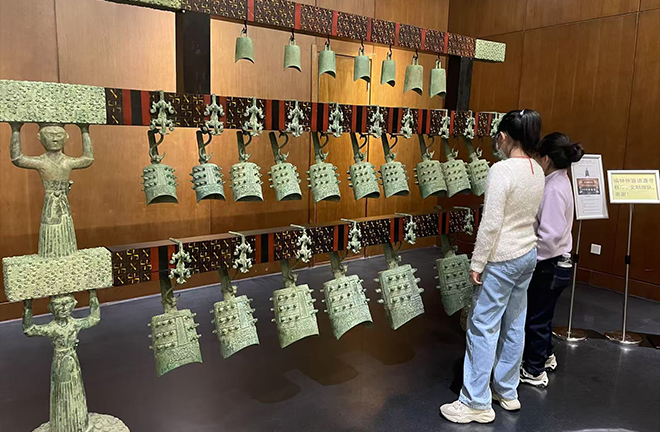Academics stress culture’s key role in national prosperity

Children learn to play bianzhong (bronze chime bells), a traditional Chinese percussion instrument set, at the Chinese Archaeological Museum in Beijing. Photo: Chen Mirong/CSST
June 2 marks the second anniversary of General Secretary of the CPC Central Committee Xi Jinping delivering a speech at a meeting on cultural inheritance and development, where he called for continued efforts to “shoulder the new cultural mission of further promoting cultural prosperity and developing a great culture in China and a modern Chinese civilization from a new starting point.”
In his address, Xi identified five prominent features of Chinese civilization—continuity, innovativeness, unity, inclusiveness, and peaceful nature—and underscored the significance of integrating the basic tenets of Marxism with China’s specific realities and fine traditional culture. Academics underscored that his remarks provided cultural direction and civilizational grounding for the nation’s great rejuvenation.
New dynamics in cultural development
Since the 18th CPC National Congress, the CPC Central Committee has elevated cultural development to a central position within national governance, with the inheritance and innovation of Chinese culture gaining fresh momentum and exhibiting new dynamics.
On April 24, the results of the 2024 selection of China’s top 10 new archaeological discoveries were announced. Among the honored sites were the Mengxihe site group in Ziyang, Sichuan Province; the Xiatang site in Xianju, Zhejiang; and the Siwa site in Lintao, Gansu. These discoveries span a broad range of topics, including the origins of humanity and the emergence and early development of Chinese civilization.
During the May Day holiday from May 1 to 5, the Chinese Archaeological Museum hosted a lecture series on the new findings that drew full audiences. Archaeologists shared stories behind the artifacts, engaging the public in a collective journey through history and culture.
Ding Sai, deputy director of the Institute of Ethnology and Anthropology at the Chinese Academy of Social Sciences, noted that fine traditional culture—including the diverse heritages of China’s many ethnic groups—is being creatively transformed into cultural industries. It is also increasingly integrated with agriculture, tourism, and services, contributing to regional economic growth.
Since the launch of the national cultural digitalization strategy, many ethnic minority regions have used digital tools to document and preserve cultural resources such as traditional villages and intangible cultural heritage (ICH). These efforts have become a vital part of the socialist culture and cultural industries with Chinese characteristics, Ding said.
Today, fine traditional Chinese culture is deeply woven into everyday life—from museum exhibitions and archaeological discoveries to the rise of “Guochao” (China-chic) fashion and ICH, from classical poetry and art to immersive performances. Qi Shuyu, a professor from the Party School of the CPC Central Committee (National Academy of Governance), emphasized that the Party and the state have lifted the preservation and utilization of traditional culture to the level of national governance, regarding fine traditions as a key intellectual resource for advancing Chinese modernization.
This approach, Qi noted, is fostering a new awakening in thought and culture, yielding new theoretical achievements, and creating new cultural milestones—continuously building up China’s cultural strength.
Prominent features of Chinese civilization
Scholars concurred that Xi’s comprehensive and systematic articulation of the five prominent features of Chinese civilization—continuity, innovativeness, unity, inclusiveness, and peaceful nature—offers vital intellectual guidance for shouldering China’s new cultural mission from a new starting point.
“Chinese civilization is a brilliant member of the human family of civilizations, a distinctive civilization with an intelligent and cooperative character,” stated Yu Wenli, deputy dean of the School of Marxism at Peking University, asserting that the five prominent features represent a comprehensive portrayal and high-level summary of Chinese civilization’s salient and fundamental attributes.
These defining features delineate the core qualities and guiding principles of Chinese culture across temporal and spatial logic, essential character, structural attributes, relational dynamics, and value orientation, Yu continued. The uninterrupted development of Chinese civilization throughout history, an attribute unique to China, is inseparable from its inclusiveness. With a peaceful approach to external cultures, Chinese civilization has drawn strength from engagement—adopting and adapting the merits of others with openness. Historical records attest to the complementary and interdependent nature of the five prominent features.
Shen Xiangping, a professor from the School of Philosophy at Renmin University of China, observed that the five prominent features not only encapsulate the genetic code of Chinese culture but also serve as fundamental principles and strategic guidelines for cultural advancement in the new era.
Continuity preserves cultural roots and supports the evolution of an advanced socialist culture. It ensures the inheritance of China’s revolutionary legacy and fine traditions, thereby reinforcing the nation’s cultural foundations, Shen explained. Innovation fuels cultural dynamism and gives rise to new forms that combine ethnic heritage with the contemporary ethos. In particular, the rise of Guochao and creative cultural tourism are helping to reframe traditional culture in ways that resonate with younger generations while invigorating the cultural sector. Unity solidifies national identity and fosters a shared identity that embraces diversity in unity, strengthening the sense of community for the Chinese nation.
Shen elaborated that inclusiveness expands cultural space and culminates in the integration of Marxist tenets with China’s fine traditions. A peaceful nature enhances China’s cultural influence, offering global contributions such as the vision of building a human community with a shared future and the promotion of shared values of humanity. These qualities shape the China’s cultural image as a nation committed to peaceful development.
“All these elements collectively constitute China’s distinctive strength in cultural development, demonstrating the contemporary vitality of Chinese civilization,” Shen added.
Edited by CHEN MIRONG

 PRINT
PRINT CLOSE
CLOSE